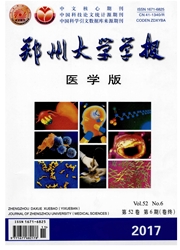

 中文摘要:
中文摘要:
目的:探讨由抗菌氟喹诺酮到抗肿瘤氟喹诺酮的构建新策略。方法:用均三唑杂环作为环丙沙星C-3羧基的生物电子等排体,硫乙酸和亚胺席夫碱为其功能修饰侧链,合成了10个新氟喹诺酮C-3均三唑硫乙酸席夫碱目标化合物(7a-7j),其结构经元素分析和光谱数据确证,评价其体外对标准金黄色葡萄球菌和大肠埃希菌及SMMC-7721、L1210和HL60 3种癌细胞的生长抑制作用。结果:目标化合物的抑菌活性明显低于母体环丙沙星,但抗肿瘤活性显著高于母体化合物,尤其是苯环含有羟基或氟原子的化合物,其IC50已达到微摩尔级,与对照阿霉素相当。结论:均三唑杂环作为氟喹诺酮C-3羧基的等排体,且被功能基侧链修饰是构建抗肿瘤氟喹诺酮分子的有效策略。
 英文摘要:
英文摘要:
Aim: To discover an efficient strategy for a conversion of antibacterial fluoroquinolones into antitumor fluoroquinolones. Methods: Ten novel fluoroquinolone C-3 s-triazole derivatives were designed and synthesized with an s-triazole ring as the C-3 bioisostere modified by both functionalized sulfanylacetic acid and imine Schiff-base side chains from ciprofloxacin,respectively. The structures of the title compounds were characterized by elemental analysis and spectral data,and the in vitro antibacterial activities against S. aureus and E. coli and antitumor activities against SMMC-7721,L1210,and HL60 cells were evaluated. Results: The title compounds demonstrated poorer antibacterial activity but more significant antitumor activity than the parent,respectively. In particular,compounds bearing a fluorine atom or nitro group attached to benzene ring were comparable to the control doxorubicin with an IC50 values of micro-molar concentration,respectively.Conclusion:It suggests that an azole modified with functionalized side-chain as the bioisosteric replacement of the C-3 carboxylic group is favorable to improvement of antitumor activity.
 同期刊论文项目
同期刊论文项目
 同项目期刊论文
同项目期刊论文
 Part II: Design, synthesis and antitumor action of C3/C3 bis-fluoroquinolones linked-cross 2,5-[1,3,
Part II: Design, synthesis and antitumor action of C3/C3 bis-fluoroquinolones linked-cross 2,5-[1,3, Synthesis and antitumor evaluation of fluoroquinolone C3 fused heterocycles (II): From triazolothiad
Synthesis and antitumor evaluation of fluoroquinolone C3 fused heterocycles (II): From triazolothiad Design, synthesis and antitumor activity of C3/C3 bis- fluoroquinolones cross-linked with [1,2,4]tri
Design, synthesis and antitumor activity of C3/C3 bis- fluoroquinolones cross-linked with [1,2,4]tri Synthesis and antitumor evaluation of C3/C3 fluoroquinolone dimmers (I): Tethered with a fused heter
Synthesis and antitumor evaluation of C3/C3 fluoroquinolone dimmers (I): Tethered with a fused heter Design, synthesis and antitumor activity of C-3/C-3 bis-fluoroquinolones cross-linked with [1,24]tri
Design, synthesis and antitumor activity of C-3/C-3 bis-fluoroquinolones cross-linked with [1,24]tri 期刊信息
期刊信息
